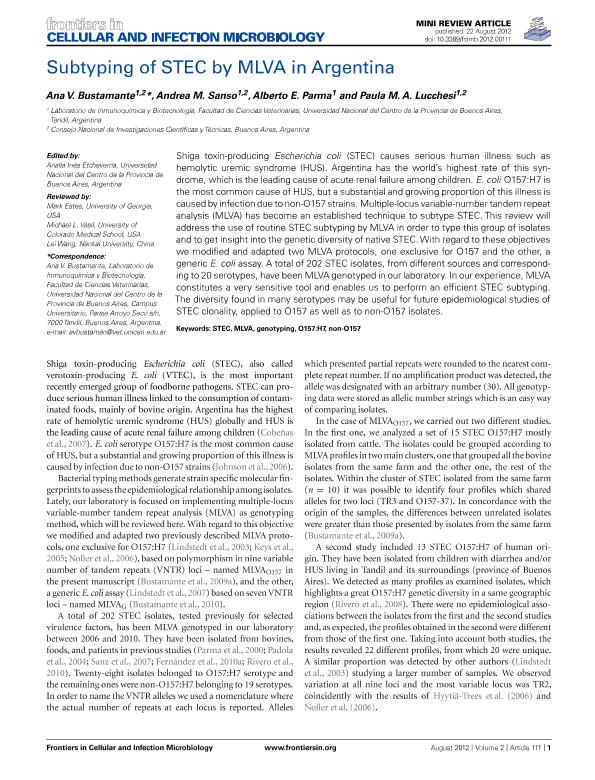Mostrar el registro sencillo del ítem
dc.contributor.author
Bustamante, Ana Victoria

dc.contributor.author
Sanso, Andrea Mariel

dc.contributor.author
Parma, Alberto Ernesto

dc.contributor.author
Lucchesi, Paula Maria Alejandra

dc.date.available
2019-02-21T21:12:40Z
dc.date.issued
2012-08
dc.identifier.citation
Bustamante, Ana Victoria; Sanso, Andrea Mariel; Parma, Alberto Ernesto; Lucchesi, Paula Maria Alejandra; Subtyping of STEC by MLVA in Argentina; Frontiers Research Foundation; Frontiers in Cellular and Infection Microbiology; 2; 8-2012; 1-4
dc.identifier.issn
2235-2988
dc.identifier.uri
http://hdl.handle.net/11336/70667
dc.description.abstract
Shiga toxin-producing Escherichia coli (STEC) causes serious human illness such as hemolytic uremic syndrome (HUS). Argentina has the world’s highest rate of this syndrome, which is the leading cause of acute renal failure among children. E. coli O157:H7 is the most common cause of HUS, but a substantial and growing proportion of this illness is caused by infection due to non-O157 strains. Multiple-locus variable-number tandem repeat analysis (MLVA) has become an established technique to subtype STEC. This review will address the use of routine STEC subtyping by MLVA in order to type this group of isolates and to get insight into the genetic diversity of native STEC. With regard to these objectives we modified and adapted two MLVA protocols, one exclusive for O157 and the other, a generic E. coli assay. A total of 202 STEC isolates, from different sources and corresponding to 20 serotypes, have been MLVA genotyped in our laboratory. In our experience, MLVA constitutes a very sensitive tool and enables us to perform an efficient STEC subtyping. The diversity found in many serotypes may be useful for future epidemiological studies of STEC clonality, applied to O157 as well as to non-O157 isolates.
dc.format
application/pdf
dc.language.iso
eng
dc.publisher
Frontiers Research Foundation

dc.rights
info:eu-repo/semantics/openAccess
dc.rights.uri
https://creativecommons.org/licenses/by-nc-sa/2.5/ar/
dc.subject
Stec
dc.subject
Mlva
dc.subject
Genotyping
dc.subject
O157:H7
dc.subject
Non-O157
dc.subject.classification
Otras Ciencias Biológicas

dc.subject.classification
Ciencias Biológicas

dc.subject.classification
CIENCIAS NATURALES Y EXACTAS

dc.title
Subtyping of STEC by MLVA in Argentina
dc.type
info:eu-repo/semantics/article
dc.type
info:ar-repo/semantics/artículo
dc.type
info:eu-repo/semantics/publishedVersion
dc.date.updated
2019-01-14T13:35:16Z
dc.journal.volume
2
dc.journal.pagination
1-4
dc.journal.pais
Suiza

dc.description.fil
Fil: Bustamante, Ana Victoria. Universidad Nacional del Centro de la Provincia de Buenos Aires. Facultad de Ciencias Veterinarias. Departamento de Sanidad Animal y Medicina Preventiva. Laboratorio de Inmunoquímica y Biotecnología; Argentina. Consejo Nacional de Investigaciones Científicas y Técnicas; Argentina
dc.description.fil
Fil: Sanso, Andrea Mariel. Universidad Nacional del Centro de la Provincia de Buenos Aires. Facultad de Ciencias Veterinarias. Departamento de Sanidad Animal y Medicina Preventiva. Laboratorio de Inmunoquímica y Biotecnología; Argentina. Consejo Nacional de Investigaciones Científicas y Técnicas; Argentina
dc.description.fil
Fil: Parma, Alberto Ernesto. Universidad Nacional del Centro de la Provincia de Buenos Aires. Facultad de Ciencias Veterinarias. Departamento de Sanidad Animal y Medicina Preventiva. Laboratorio de Inmunoquímica y Biotecnología; Argentina. Consejo Nacional de Investigaciones Científicas y Técnicas; Argentina
dc.description.fil
Fil: Lucchesi, Paula Maria Alejandra. Universidad Nacional del Centro de la Provincia de Buenos Aires. Facultad de Ciencias Veterinarias. Departamento de Sanidad Animal y Medicina Preventiva. Laboratorio de Inmunoquímica y Biotecnología; Argentina. Consejo Nacional de Investigaciones Científicas y Técnicas; Argentina
dc.journal.title
Frontiers in Cellular and Infection Microbiology
dc.relation.alternativeid
info:eu-repo/semantics/altIdentifier/doi/http://dx.doi.org/10.3389/fcimb.2012.00111
dc.relation.alternativeid
info:eu-repo/semantics/altIdentifier/url/https://www.frontiersin.org/articles/10.3389/fcimb.2012.00111/full
dc.relation.alternativeid
info:eu-repo/semantics/altIdentifier/url/https://www.ncbi.nlm.nih.gov/pmc/articles/PMC3424435/
Archivos asociados
